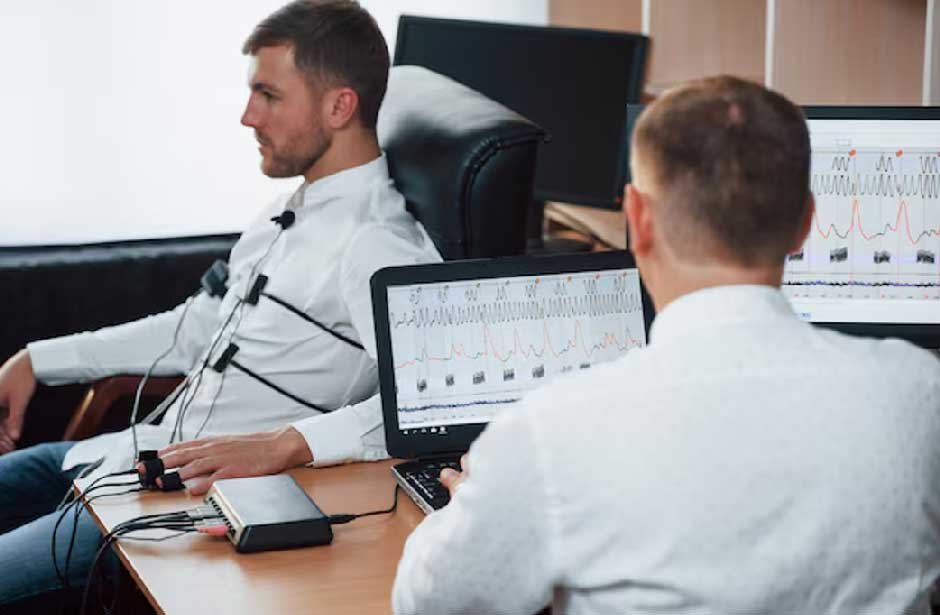Skip to the good bit
ToggleThe idea of a lie detector test can be unsettling. Few people enjoy being strapped to a machine that claims to know them better than they know themselves. Despite the dramatics of crime dramas, the process is neither mysterious nor magical. It is, however, methodical.
A properly conducted polygraph exam takes between 1.5 to 2.5 hours because accuracy depends on thoroughness. There’s preparation, question design, and data analysis. It’s not a matter of asking, “Did you do it?” and waiting for a blinking light to flash red.
That said, a Polygraph relies on the body’s physiological responses, specifically those controlled by the autonomic nervous system. Lying, at least for most people, isn’t a neutral act. It triggers reactions—ones that the polygraph is trained to catch. It doesn’t read minds or decode guilt, but it detects changes in blood pressure, breathing, and perspiration when someone experiences pressure.
Keep reading to know more about how lie detectors work.
Understanding the Lie Detector Test Process
A lie detector test doesn’t start when the subject is attached to the machine. It starts with a detailed pre-test interview.
The examiner gets background information to ensure the person is a suitable candidate for the test. Moreover, in this stage, the examiner explains how the test works and addresses any misconceptions that could affect the subject’s answers. Nervousness won’t fail you, but excessive anxiety or a lack of understanding can create unnecessary complications.
Next is question formulation. Questions are designed to get clear physiological responses. They have to be unambiguous. Contrary to popular myth, more questions don’t mean more accuracy. The fewer relevant questions, the more accurate the test will be. A single relevant question asked multiple times gives a much more precise reading than multiple questions diluting the data.
Once the test starts, the subject is attached to sensors that monitor physiological responses. The same questions are asked multiple times in different orders. This isn’t about scaring you—it’s about getting enough data to make a decision. After the test, the results are scored numerically.
Designing Polygraph Questions
One of the main rules when designing polygraph questions is that all questions must be answered with a simple yes or no. Narrative answers are not allowed, so answers must be clear and concise. In general, suspects will answer no and victims and witnesses will answer yes. This clear format allows the examiner to quickly assess physiological reactions to each answer, which is key to the test.
Also, polygraph questions must be objective and unambiguous. Each question must be interpretable by anyone who hears it regardless of their background or perspective. To avoid confusion, specific words or phrases can be defined and agreed upon beforehand if there is any doubt about their meaning.
Moreover, questions should be concise, as questions that take more than 6 or 7 seconds to ask are considered too long. Long questions can confuse and disrupt the flow of the test.

There are also types of questions that are not allowed in polygraph tests. Hypothetical questions, questions about emotions or opinions and compound (multi-part) questions are not allowed. For example, an examiner cannot ask, “Are you lying about stealing the missing wallet?” Instead, a direct question like “Did you steal the missing wallet?” would be used.
Measuring the Body’s Reactions
A polygraph measures physiological responses to perceived threats or consequences. Lying doesn’t produce a universal response, but the fear of getting caught in a lie triggers the body’s defense mechanisms. When a person believes deception will lead to legal, financial or personal punishment, their autonomic nervous system responds accordingly.

The test monitors several key indicators. Blood pressure changes indicate stress, and respiration patterns reveal controlled breathing or irregularity. Furthermore, electrodermal activity – essentially measuring sweat gland activity – shows changes in skin conductivity, often heightened under pressure. Some polygraph machines also track blood volume and motion to ensure physical movement isn’t used to manipulate the results.
This scenario is related to cognitive dissonance. Telling the truth is a natural state that requires no effort. Lying requires a person to override their natural response, creating internal conflict. That conflict, plus fear of consequences, produces measurable physiological responses. These don’t mean someone is lying, but they produce a pattern that, when analyzed by an experienced examiner, can indicate deception.
Truth About Polygraph Accuracy
The accuracy of a polygraph test depends on multiple factors: the examiner’s training, the question format, and the type of test administered. A properly conducted single-issue test using validated techniques can reach an accuracy level above 90%.
This level of reliability doesn’t mean polygraphs are infallible. No test can guarantee absolute truth. However, when administered correctly, they offer a strong indicator of deception. The mistake many people make is assuming that polygraphs work as they do on television—where a single beep or flashing light delivers an instant verdict. In reality, results require careful analysis.
Polygraph works because deception is rarely neutral. Lying often triggers physiological reactions—ones that the polygraph records in real-time. It doesn’t detect lies directly but measures the body’s response to deception. Combined with expert analysis, this data provides a valuable tool for truth verification.
Conclusion
Lie detector tests are as much about science as they are about psychology. They don’t decode thoughts or catch lies in real-time. Instead, they measure how the body responds under pressure. When conducted properly, they offer a remarkably high degree of accuracy.
The process is neither instant nor effortless. It requires preparation, precision, and expertise. A well-structured test provides reliable results—but only when handled by a qualified examiner. Furthermore, a lie detector isn’t a magic truth serum but a scientifically validated tool for uncovering deception. If truth matters, then the method of finding it does too.







